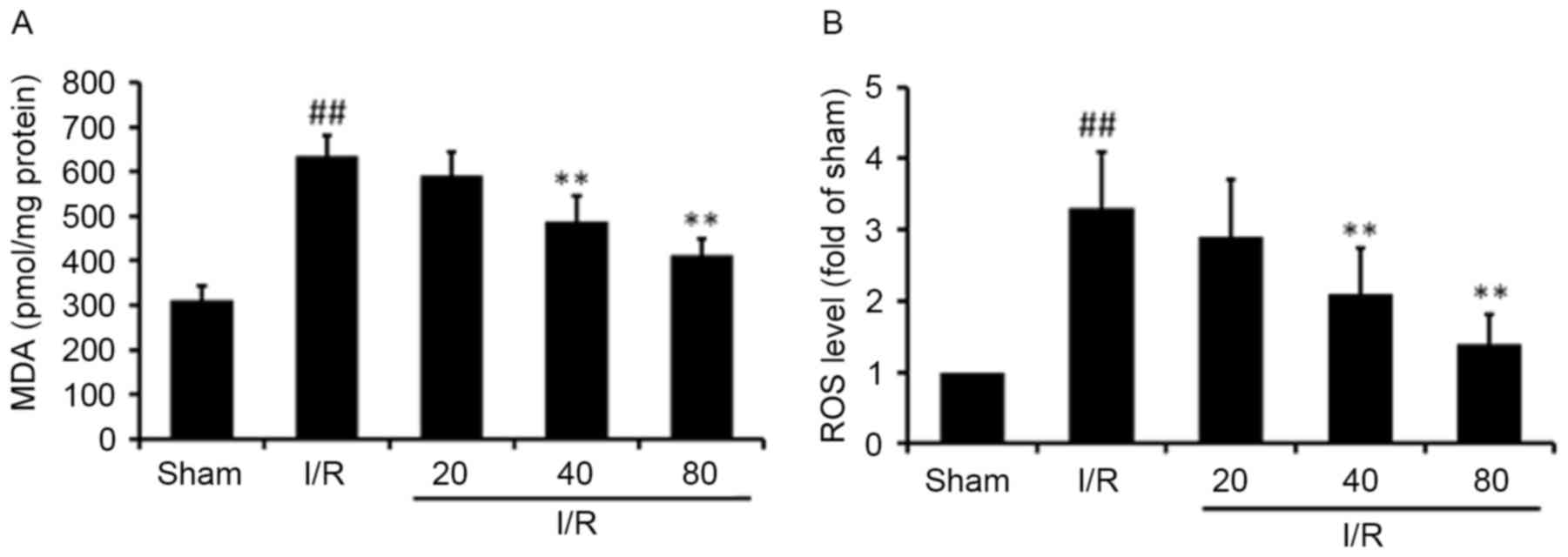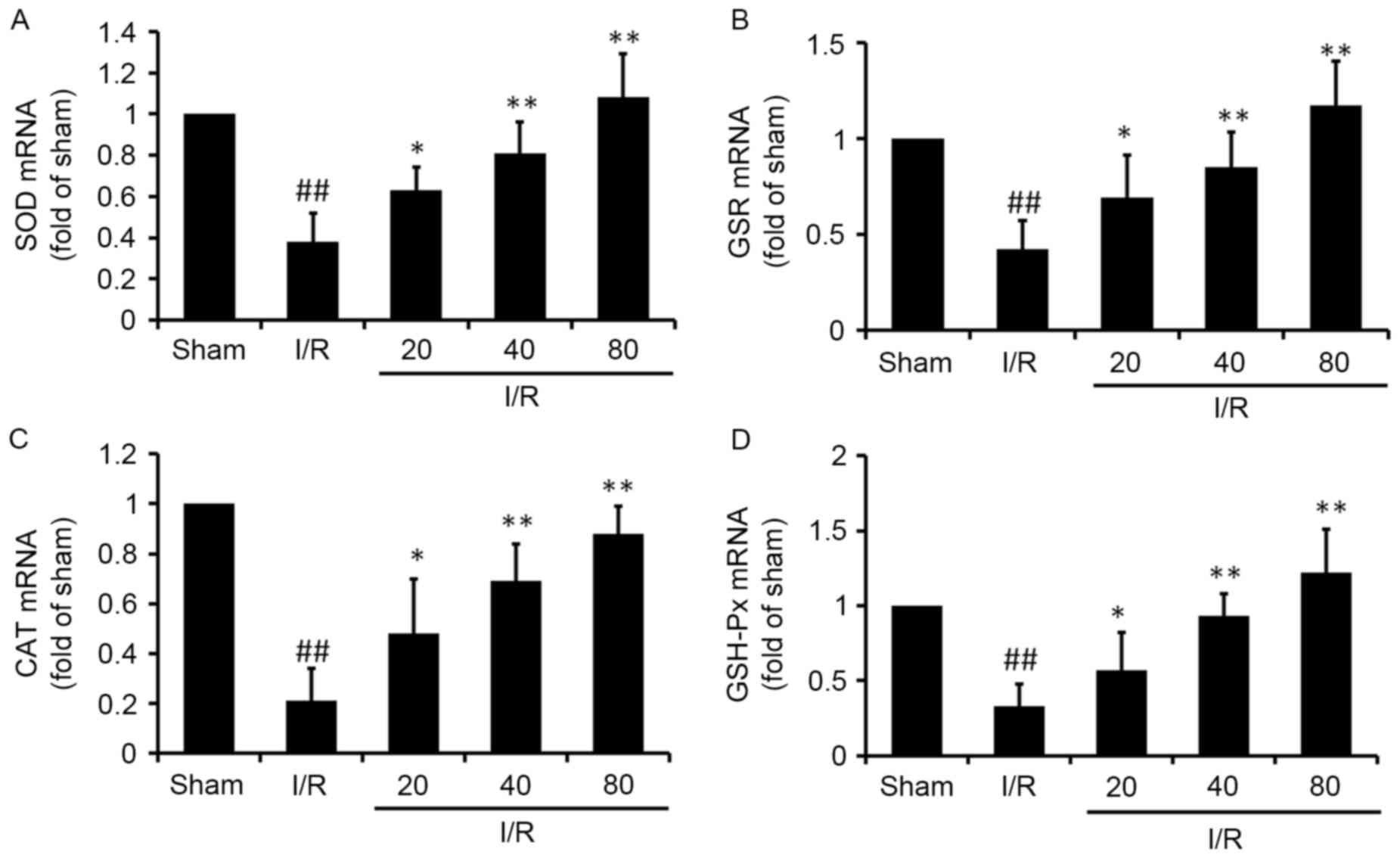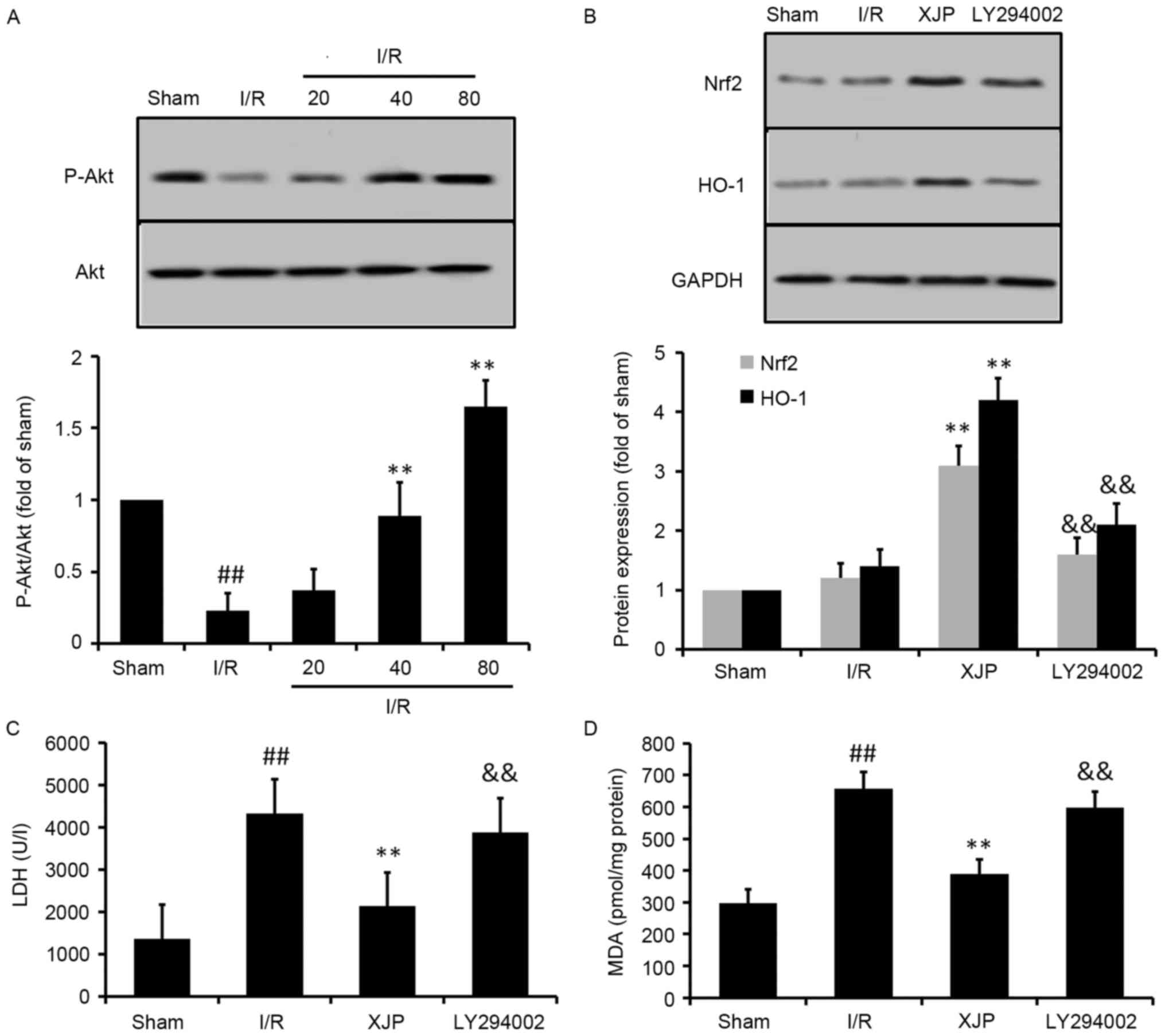|
1
|
Zhong X, Li X, Qian L, Xu Y, Lu Y, Zhang
J, Li N, Zhu X, Ben J, Yang Q and Chen Q: Glycine attenuates
myocardial ischemia-reperfusion injury by inhibiting myocardial
apoptosis in rats. J Biomed Res. 26:346–354. 2012. View Article : Google Scholar : PubMed/NCBI
|
|
2
|
Piper HM, García-Dorado D and Ovize M: A
fresh look at reperfusion injury. Cardiovasc Res. 38:291–300. 1998.
View Article : Google Scholar : PubMed/NCBI
|
|
3
|
Jennings RB, Sommers HM, Smyth GA, Flack
HA and Linn H: Myocardial necrosis induced by temporary occlusion
of a coronary artery in the dog. Arch Pathol. 70:68–78.
1960.PubMed/NCBI
|
|
4
|
Armstrong SC: Protein kinase activation
and myocardial ischemia/reperfusion injury. Cardiovasc Res.
61:427–436. 2004. View Article : Google Scholar : PubMed/NCBI
|
|
5
|
Go AS, Mozaffarian D, Roger VL, Benjamin
EJ, Berry JD, Borden WB, Bravata DM, Dai S, Ford ES, Fox CS, et al:
Heart disease and stroke statistics-2013 update: A report from the
American Heart Association. Circulation. 127:e6–e245. 2013.
View Article : Google Scholar : PubMed/NCBI
|
|
6
|
Murphy E and Steenbergen C: Mechanisms
underlying acute protection from cardiac ischemia-reperfusion
injury. Physiol Rev. 88:581–609. 2008. View Article : Google Scholar : PubMed/NCBI
|
|
7
|
Becker LB: New concepts in reactive oxygen
species and cardiovascular reperfusion physiology. Cardiovasc Res.
61:461–470. 2004. View Article : Google Scholar : PubMed/NCBI
|
|
8
|
Frangogiannis NG, Smith CW and Entman ML:
The inflammatory response in myocardial infarction. Cardiovasc Res.
53:31–47. 2002. View Article : Google Scholar : PubMed/NCBI
|
|
9
|
Laskowski A, Woodman OL, Cao AH, Drummond
GR, Marshall T, Kaye DM and Ritchie RH: Antioxidant actions
contribute to the antihypertrophic effects of atrial natriuretic
peptide in neonatal rat cardiomyocytes. Cardiovas Resear.
72:112–123. 2006. View Article : Google Scholar
|
|
10
|
Moens AL, Claeys MJ, Timmermans JP and
Vrints CJ: Myocardial ischemia/reperfusion-injury, a clinical view
on a complex pathophysiological process. Int J Cardiol.
100:179–190. 2005. View Article : Google Scholar : PubMed/NCBI
|
|
11
|
Rajak S, Banerjee SK, Sood S, Dinda AK,
Gupta YK, Gupta SK and Maulik SK: Emblica officinalis causes
myocardial adaptation and protects against oxidative stress in
ischemic-reperfusion injury in rats. Phytother Res. 18:54–60. 2004.
View Article : Google Scholar : PubMed/NCBI
|
|
12
|
Li J, Ichikawa T, Villacorta L, Janicki
JS, Brower GL, Yamamoto M and Cui T: Nrf2 protects against
maladaptive cardiac responses to hemodynamic stress. Arterioscler
Thromb Vasc Biol. 29:1843–1850. 2009. View Article : Google Scholar : PubMed/NCBI
|
|
13
|
McMahon M, Itoh K, Yamamoto M and Hayes
JD: Keap1-dependent proteasomal degradation of transcription factor
Nrf2 contributes to the negative regulation of antioxidant response
element-driven gene expression. J Biol Chem. 278:21592–21600. 2003.
View Article : Google Scholar : PubMed/NCBI
|
|
14
|
Boran AD and Iyengar R: Systems approaches
to polypharmacology and drug discovery. Curr Opin Drug Discov
Devel. 13:297–309. 2010.PubMed/NCBI
|
|
15
|
Zhang A and Hui A: Inhibition of coxsackie
virus and effect on the treatment of viral myocarditis of Xinji
Pill in mice. Shanxi Tradit Chin Med. 12:563–564. 1998.(In
Chinese).
|
|
16
|
National Research Council (US) Committee
for the Update of the Guide for the Care and Use of Laboratory
Animals: Guide for the Care and Use of Laboratory Animals. 8th.
National Academies Press (US); Washington, DC: pp. 1072–1073.
2011
|
|
17
|
China's food and drug administration, .
Good laboratory practice. Standards Press of China; Beijing: pp.
54–59. 2003
|
|
18
|
China's food and drug administration: Good
manufacturing practice. Standards Press of China; Beijing: pp.
106–109. 2015
|
|
19
|
Tao L, Gao E, Bryan NS, Qu Y, Liu HR, Hu
A, Christopher TA, Lopez BL, Yodoi J, Koch WJ, et al:
Cardioprotective effects of thioredoxin in myocardial ischemia and
reperfusion: Role of S-nitrosation (corrected). Proc Natl Acad Sci
USA. 101:11471–11476. 2004. View Article : Google Scholar : PubMed/NCBI
|
|
20
|
Cao Z and Li Y: Protecting against
peroxynitrite-mediated cytotoxicity in vascular smooth muscle cells
via upregulating endogenous glutathione biosynthesis by
3H-1,2-dithiole-3-thione. Cardiovasc Toxicol. 4:339–353. 2004.
View Article : Google Scholar : PubMed/NCBI
|
|
21
|
Livak KJ and Schmittgen TD: Analysis of
relative gene expression data using real-time quantitative PCR and
the 2(−Delta Delta C(T)) Method. Methods. 25:402–408. 2001.
View Article : Google Scholar : PubMed/NCBI
|
|
22
|
Hu W, Zhang P, Gu J, Yu Q and Zhang D:
NEDD4-1 protects against ischaemia/reperfusion-induced
cardiomyocyte apoptosis via the PI3K/Akt pathway. Apoptosis.
22:437–448. 2017. View Article : Google Scholar : PubMed/NCBI
|
|
23
|
Cho MH, Niles A, Huang R, Inglese J,
Austin CP, Riss T and Xia M: A bioluminescent cytotoxicity assay
for assessment of membrane integrity using a proteolytic biomarker.
Toxicol In Vitro. 22:1099–1106. 2008. View Article : Google Scholar : PubMed/NCBI
|
|
24
|
Corey MJ, Kinders RJ, Brown LG and
Vessella RL: A very sensitive coupled luminescent assay for
cytotoxicity and complement-mediated lysis. J Immunol Methods.
207:43–51. 1997. View Article : Google Scholar : PubMed/NCBI
|
|
25
|
Kim H, Yoon SC, Lee TY and Jeong D:
Discriminative cytotoxicity assessment based on various cellular
damages. Toxicol Lett. 184:13–17. 2009. View Article : Google Scholar : PubMed/NCBI
|
|
26
|
Wu Y and Yuan BX: Effects of Qiangxin
capsules on myocardial reperfusion arrhythmias in rats. Northwest
Pharmac J. 16:23–24. 2001.
|
|
27
|
Fu J, Huang H, Liu J, Pi R, Chen J and Liu
P: Tanshinone IIA protects cardiac myocytes against oxidative
stress-triggered damage and apoptosis. Eur J Pharmac. 568:213–221.
2007. View Article : Google Scholar
|
|
28
|
Halliwell B and Gutteridge JMC: Free
radicals in biology and medicine. 3rd. Oxford: Clarendon Press; pp.
246–350. 1999
|
|
29
|
Maxwell SR and Lip GY: Reperfusion injury:
A review of the pathophysiology, clinical manifestations and
therapeutic options. Int J Cardiol. 58:95–117. 1997. View Article : Google Scholar : PubMed/NCBI
|
|
30
|
Duranteau J, Chandel NS, Kulisz A, Shao Z
and Schumacker PT: Intracellular signaling by reactive oxygen
species during hypoxia in cardiomyocytes. J Biol Chem.
273:11619–11624. 1998. View Article : Google Scholar : PubMed/NCBI
|
|
31
|
Hensley K, Robinson KA, Gabbita SP,
Salsman S and Floyd RA: Reactive oxygen species, cell signaling,
and cell injury. Free Radic Biol Med. 28:1456–1462. 2000.
View Article : Google Scholar : PubMed/NCBI
|
|
32
|
Das DK and Maulik N: Antioxidant
effectiveness in ischemia reperfusion tissue injury. Methods
Enzymol. 233:601–610. 1994. View Article : Google Scholar : PubMed/NCBI
|
|
33
|
Lefer DJ and Granger DN: Oxidative stress
and cardiac disease. Am J Med. 109:315–323. 2000. View Article : Google Scholar : PubMed/NCBI
|
|
34
|
Ferrari R, Ceconi C, Curello S, Cargnoni
A, Alfieri O, Pardini A, Marzollo P and Visioli O: Oxygen free
radicals and myocardial damage: Protective role of thiolcontaining
agents. Am J Med. 91 Suppl:95–105. 1991. View Article : Google Scholar
|
|
35
|
Frei B: On the role of vitamin C and other
antioxidants in atherogenesis and vascular dysfunction. Proc Soc
Exp Biol Med. 222:196–204. 1999. View Article : Google Scholar : PubMed/NCBI
|
|
36
|
Valko M, Rhodes CJ, Moncol J, Izakovic M
and Mazur M: Free radicals, metals and antioxidants in oxidative
stress-induced cancer. Chem Biol Interact. 160:1–40. 2006.
View Article : Google Scholar : PubMed/NCBI
|
|
37
|
Tengattini S, Reiter RJ, Tan DX, Terron
MP, Rodella LF and Rezzani R: Cardiovascular diseases: Protective
effects of melatonin. J Pineal Res. 44:16–25. 2008.PubMed/NCBI
|
|
38
|
Ma Q, Kinneer K, Bi Y, Chan JY and Kan YW:
Induction of murine NAD(P)H:quinine oxidoreductase by
2,3,7,8-tetrachlorodibenzo-p-dioxin requires the CNC (cap ‘n’
collar) basic leucine zipper transcription factor Nrf2 (nuclear
factor erythroid 2-related factor 2): Cross-interaction between AhR
(aryl hydrocarbon receptor) and Nrf2 signal transduction. Biochem
J. 377:205–213. 2004. View Article : Google Scholar : PubMed/NCBI
|
|
39
|
He X, Chen MG, Lin GX and Ma Q: Arsenic
induces NAD(P)H-quinone oxidoreductase I by disrupting the Nrf2 ×
Keap1 x·Cul3 complex and recruiting Nrf2 x·Maf to the antioxidant
response element enhancer. J Biol Chem. 281:23620–23631. 2006.
View Article : Google Scholar : PubMed/NCBI
|
|
40
|
Su JD, Yen JH, Li S, Weng CY, Lin MH, Ho
CT and Wu MJ: 3′,4′-didemethylnobiletin induces phase II
detoxification gene expression and modulates PI3K/Akt signaling in
PC12 cells. Free Radic Biol Med. 52:126–141. 2012. View Article : Google Scholar : PubMed/NCBI
|















